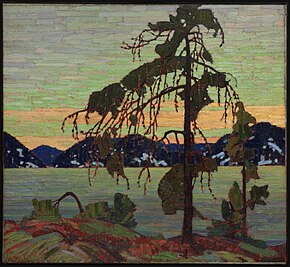
Back فن كندي Arabic ཁ་ན་ཌ་ཀྱི་སྒྱུ་རྩལ། Tibetan Ealaín Cheanada Irish Kanadisk kunst NN ਕੈਨੇਡੀਅਨ ਕਲਾ Punjabi Pintura do Canadá Portuguese Искусство Канады Russian
| Part of a series on the |
| Canadian art |
|---|

Canadian art refers to the visual (including painting, photography, and printmaking) as well as plastic arts (such as sculpture) originating from the geographical area of contemporary Canada. Art in Canada is marked by thousands of years of habitation by Indigenous peoples followed by waves of immigration which included artists of European origins and subsequently by artists with heritage from countries all around the world. The nature of Canadian art reflects these diverse origins, as artists have taken their traditions and adapted these influences to reflect the reality of their lives in Canada.
The Government of Canada has played a role in the development of Canadian culture, through the department of Canadian Heritage by giving grants to art galleries,[1] as well as establishing and funding art schools and colleges across the country, and through the Canada Council for the Arts (established in 1957), the national public arts funder, helping artists, art galleries and periodicals, thus contributing to the visual exposure of Canada's heritage.[2] The Canada Council Art Bank also helps artists by buying and publicizing their work. The Canadian government has sponsored four official war art programs: the First World War Canadian War Memorials Fund (CWMF), the Second World War Canadian War Records (CWR), the Cold War Canadian Armed Forces Civilian Artists Program (CAFCAP), and the current Canadian Forces Artists Program (CFAP).[3]
The Group of Seven is often considered the first uniquely Canadian artistic group and style of painting;[4] however, this claim is challenged by scholars and artists.[5] Historically, the Catholic Church was the primary patron of art in early Canada, especially Quebec, and in later times, artists have combined British, French, and American artistic traditions, at times embracing European styles and at the same time, working to promote nationalism. Canadian art remains the combination of these various influences.
- ^ as, for instance, in the following example of a show funded by the Government of Canada at the Peel Art Gallery Museum + Archives, Brampton:"Putting a spotlight on Canada's Artistic Heritage". www.canada.ca. Government of Canada. January 14, 2020. Retrieved March 24, 2021.
- ^ "Canada Council for the Arts". www.linkedin.com. linked in. Retrieved March 23, 2021.
- ^ Brandon, Laura (2021). War Art in Canada: A Critical History. Toronto: Art Canada Institute. ISBN 978-1-4871-0271-5.
- ^ Lynda Jessup (2001). Antimodernism and artistic experience: policing the boundaries of modernity. University of Toronto Press. p. 146. ISBN 978-0-8020-8354-8.
- ^ The essay collection Sightlines: Reading Contemporary Canadian Art (edited by Jessica Bradley and Lesley Johnstone, Montreal: Artexte Information Centre, 1994) contains a number of critical texts addressing the issues around the difficulty of establishing or even defining a Canadian identity.
